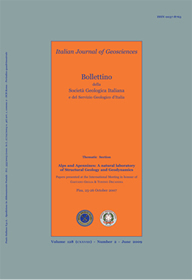
Oligocene-Miocene foredeep deposits in the Lake Trasimeno area (Central Italy): insights into the evolution of the Northern Apennines
Marco Barsella(*), Arnaldo Boscherini(**), Flavia Botti(*), Michele Marroni(*)(***), Francesca Meneghini(*), Andrea Motti(**), Silvia Palandri(*) & Luca Pandolfi(*)(***)
(*) Dipartimento di Scienze della Terra, Università di Pisa.
(**) Servizio Geologico, Regione Umbria.
(***) Istituto di Geoscienze e Georisorse, CNR.
Corresponding author: Prof. Michele Marroni, Dipartimento di Scienze della Terra (Università di Pisa), Via S. Maria, 53 - 56126 Pisa, Italy. E-mail: marroni@dst.unipi.it, tel.: +39-050-2215732, Fax.: +39-050-2215800.
Volume: 128 (2009) f.2
Pages: 341-352
Abstract
In the Trasimeno Lake area (Umbria Region), several thrust sheets belonging to the Sansepolcro-Monte Filoncio and Rentella Units, are interposed between the Tuscan Nappe (in the hanging-wall) and the Umbria-Romagna Unit (in the footwall). The thrust sheets succession of the Sansepolcro-Monte Filoncio Unit is made up of Rupelian-Chattian Scaglia toscana Fm. and Chattian-Aquitanian foredeep deposits of Macigno Fm.; the base of the siliciclastic succession becomes gradually younger eastward. The compositional mode of the fine-grained rock fragments in the arenaceous turbidites is comparable with that of the upper part of the Macigno Fm. in the Tuscan Nappe.
The succession of the Rentella Unit includes Rupelian-Aquitanian Monte Rentella Fm. and Aquitanian-Burdigalian foredeep siliciclastic turbidites of the Montagnaccia Fm.. In the lower portion of the Montagnaccia Fm. a level of black cherty horizons is present, as detected in all Aquitanian-Burdigalian successions of the Northern Apennines. The compositional mode of the fine-grained rock fragments in the turbidites is comparable with that of Marnoso-Arenacea Fm..
All these data allow an Oligocene-Miocene paleogeographic reconstruction of the Northern Apennines foredeep. Based on the age, the compositional mode and structural position, the Rentella and Sansepolcro-Monte Filoncio Units can be compared to the Carigiola and Acquerino Units cropping out in the Tuscan-Emilian Apennines.
Keywords
Foredeep deposits, Oligocene-Miocene, arenites petrography, biostratigraphy, Northern Apennines, Trasimeno Lake area.
Get Full Text